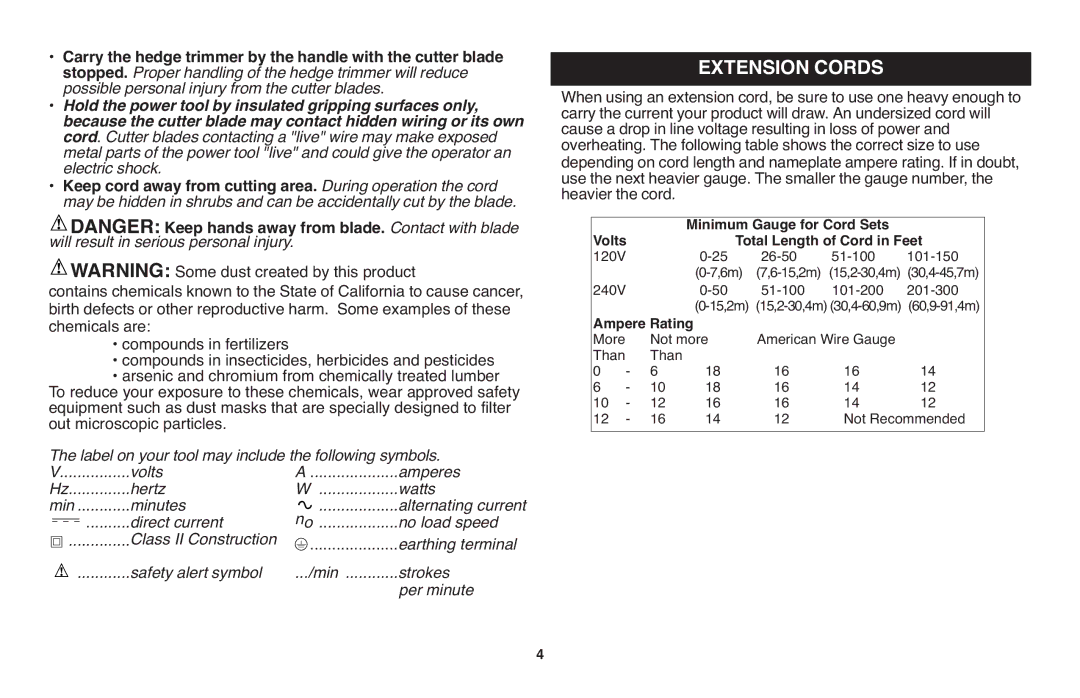
• | Carry the hedge trimmer by the handle with the cutter blade | |||||
| stopped. Proper handling of the hedge trimmerwill reduce | |||||
• | possible personal injury from the cutter blades. |
| ||||
Hold the power tool by insulated gripping surfaces only, | ||||||
| because the cutter blade may contact hidden wiring or its own | |||||
| cord. Cutter blades contacting a "live" wire may make exposed | |||||
| metal parts of the power tool "live" and could give the operator an | |||||
• | electric shock. |
|
|
|
| |
Keep cord away from cutting area. During operation the cord | ||||||
| may be hidden in shrubs and can be accidentally cut by the blade. | |||||
| DANGER: Keep hands away from blade. Contact with blade | |||||
will result in serious personal injury. |
|
|
|
| ||
| WARNING: Some dust created by this product | |||||
contains chemicals known to the State of California to cause cancer, | ||||||
birth defects or other reproductive harm. Some examples of these | ||||||
chemicals are: |
|
|
|
| ||
|
| • compounds in fertilizers |
|
|
|
|
|
| • compounds in insecticides, herbicides and pesticides | ||||
|
| • arsenic and chromium from chemically treated lumber | ||||
To reduce your exposure to these chemicals, wear approved safety | ||||||
equipment such as dust masks that are specially designed to filter | ||||||
out microscopic particles. |
|
|
|
| ||
The label on your tool may include the following symbols. | ||||||
V | ................ | volts | A | amperes | ||
Hz | hertz | W | watts | |||
min | minutes | no | alternating current | |||
| .......... | direct current | no load speed | |||
| .............. | Class II Construction |
|
| .................... | earthing terminal |
| ............ | safety alert symbol | .............../min | strokes | ||
|
|
|
|
|
| per minute |
|
|
|
| EXTENSION CORDS |
|
| |||
When using an extension cord, be sure to use oneheavy enoughto | |||||||||
carry the current your product will draw. Anundersized cord will | |||||||||
cause a drop in line voltage resultingin loss of power and | |||||||||
overheating. The following table shows thecorrect size touse | |||||||||
depending on cord length andnameplate ampere rating. Ifin doubt, | |||||||||
use the next heavier gauge. The smallerthe gauge number, the | |||||||||
heavier the cord. | Minimum Gauge for Cord Sets |
|
| ||||||
| Volts |
|
|
| |||||
|
| Total Length of Cord in Feet |
| ||||||
| 120V |
|
|
| |||||
| 240V |
|
| ||||||
|
|
|
| ||||||
| Ampere |
| |||||||
| More |
| Not more |
| American Wire Gauge |
|
| ||
| Than | - | Than | 18 |
| 16 | 16 | 14 |
|
| 0 | 6 |
|
| |||||
| 6 | - | 10 | 18 |
| 16 | 14 | 12 |
|
| 10 | - | 12 | 16 |
| 16 | 14 | 12 |
|
| 12 | - | 16 | 14 |
| 12 | Not Recommended |
| |
4
